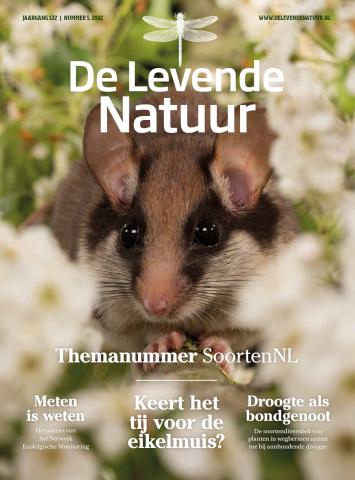De Levende Natuur nummer 5 van 2022 (English summary)
Thema
Afbeelding

A research agenda for species conservation in the 21st Century
Michiel Wallis de Vries & Laurens Sparrius
The evidence base for species conservation rests on a well-structured information flow from observing, identifying and recording species to the assessment of the status and trends in their distribution and populations. In the Netherlands, species records and counts are largely collected by volunteers. Nine organisations coordinate these efforts for different species groups and promote the use of these data for research and conservation. The organisations collaborating in SoortenNL now have formulated a research agenda with focal questions in the fields of species identification, species recording and counting, assessment of distribution and trends, and finally, identifying main threats and measures for species conservation. Close cooperation with both research institutes and conservation practitioners is necessary to address this research agenda in the future.
Wooded banks and slope forests - habitat restoration for the garden dormouse
Ellen van Norren
The garden dormouse with its large plume tail and black mask is critically endangered and critically unknown in the Netherlands. The unfamiliarity with this reclusive animal has led to a lack of protection measures and a lack of research. But the tides seem to be turning. Research in the Netherlands, Flanders and Germany in 2022 will hopefully provide further insight into habitat use of the garden dormouse. The species seems to be dependent of varied forest edges, hedges and haggard fallow lands. These are under pressure, among other things due to the cleaning up of the landscape, both in agriculture and in forest management. Habitat restoration will hopefully start in 2022, in the Netherlands proclaimed as Year of the Garden Dormouse, to increase national awareness of the species.
Basic Nature Quality: focus on common species
Henk Sierdsema, Christian Kampichler, Michiel Wallis de Vries & Ronald Zollinger
The Basic Nature Quality concept emphasizes the provision of suitable conditions to keep common species common. In the course of decades we have seen many of these species decline in distribution and numbers to such an extent that they are placed on the Red List. And we want to prevent this! Particularly for agricultural and urban nature, the restoration of basic nature quality is an important new ambition for the new nature policy. Indicator species have now been selected from seventeen species groups of plants and animals for assessment. With these species we define the desired local basic nature quality and compare this with the current occurrence to define targets for quality improvement.
Steering grazers for the heathland fauna
Michiel Wallis de Vries, Marijn Nijssen, John Smit, Jinze Noordijk & Ronald Zollinger
Large-scale grazing on heathland often leads to overgrazing or undergrazing at local scales. This can be detrimental to the fauna. Local fine-tuning of grazing intensity may offer a solution. Using an experimental approach, we investigated the effects of extensification by temporary exclosures and intensification by high-intensity sheep grazing over a six-year period. For, butterflies, day-active moths, grasshoppers and ants, we found contrasting effects between pionieer species benefitting from high-intensity grazing and old-growth species performing best in exclosures. Bees and hoverflies were more dependent on flower abundance than on grazing intensity itself, but many bees also require open ground for nesting. Viviparous lizards and eggs of ground-nesting birds were most vulnerable to high grazing intensity. Overall, the experiment shows that manipulating grazing intensity for the benefit of heathland animals is feasible, but achieving the desired small-scale habitat heterogeneity does present a challenge.
Knowledge is power – Network Ecological Monitoring
Edo Goverse, Tariq Stark, Marnix P. de Zeeuw, Ingo Janssen & Jelger E. Herder
Monitoring of biodiversity has a long-standing history in the Netherlands. Statistics Netherlands started the departments for Environmental Statistics (1969) and Nature Statistics (1974) with the aim to gain reliable insights in environmental issues in the Netherlands. The earliest National Monitoring schemes were implemented from the late 1970’s, mainly for birds and butterflies, soon followed by other taxa, both floral and faunal. In 1999 all of these monitoring schemes were unified within the Network Ecological Monitoring (NEM). In this paper the history of the NEM and its monitoring schemes are discussed. The Dutch National Reptile Monitoring Scheme, one of the oldest running programs, is used as an example for other NEM monitoring programs.
Counting butterflies in time and space
Chris van Swaay, Tim Termaat, Jaap Bouwman, Roy van Grunsven, Gerdien Bos & Nelleke Cornips
Spatial inventories provide an insight in the distribution of butterflies over an area (e.g., a nature reserve). But comparing two of such inventories over time can be a problem, as butterflies have a short flight period, and the flight peak is easily missed when only few surveys are made. In this paper we show that transect monitoring data from the surroundings can be used to correct for that and calculate spatial densities which can be compared in time and space. Furthermore, this offers the opportunity to compare these changes with the trend of the surrounding area, thus making it possible to distinguish between large scale (as climate change) and local causes (as mowing regime).
Drought accellerates changes in road verge vegetation
Laurens Sparrius
Grassland vegetations in the Netherlands are increasing subjected to extreme drought in the growing season. Monitoring schemes in road verges showed a rapid shift from perennials to annuals and monocarps. Also, a decrease of grass cover and increase in forb cover is observed. Although the old situation is slowly restored in years with normal precipitation, the author expects that on the long run, with dry years occurring more frequently, road verges will become more diverse and richer in forbs. The increase in nectar plants could improve biodiversity in rural areas without actually changing the mowing regime.

